7.6 /10 1 Votes
8/10 TV Created by Al Howard Country of origin United States Final episode date 23 May 2003 Number of episodes 1,111 | 7.3/10 IMDb Theme music composer Christopher Rhyne First episode date 20 December 1965 Program creator Al Howard | |||||||||||||||||||||||||||||||||
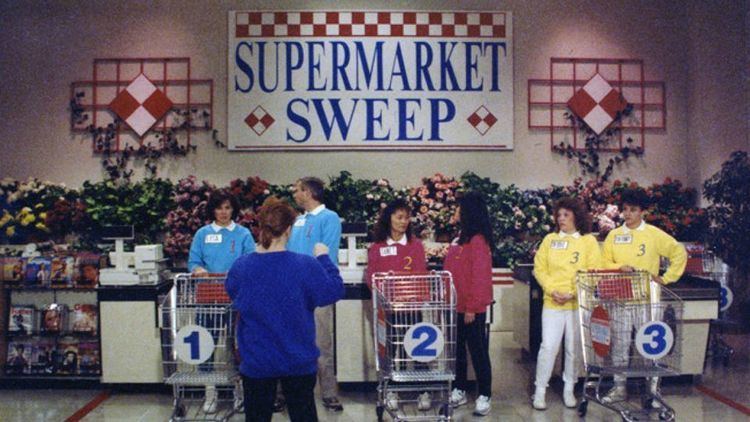 | ||||||||||||||||||||||||||||||||||
Directed by Lloyd Gross (1965–67)Peter Molnár (1965–67)Chris Darley (1990–95, 2000–03) Narrated by Wally King (1965–66)Richard Hayes (1966–67)Johnny Gilbert (1990–95, 2000)Randy West (2000–03) Nominations Daytime Emmy Award for Outstanding Art Direction/Set Decoration/Scenic Design Similar Dale's Supermarket Sweep, Game show, Shop 'til You Drop, Press Your Luck, Tic‑Tac‑Dough | ||||||||||||||||||||||||||||||||||
Supermarket sweep 1994 full game
Supermarket Sweep is an American television game show. The format combined an ordinary team-based quiz show with the novel concept of a live, timed race through a supermarket. In the timed race, cameras followed the teams with shopping carts through a large vacated supermarket with several aisles; the value of items thrown into the cart determined the winning team. The original show was broadcast on ABC from December 20, 1965 to July 14, 1967. Revivals aired on Lifetime from February 5, 1990, to June 16, 1995 (with reruns until August 14, 1998, and on PAX from April 5, 1999, to March 31, 2000), and later from April 3, 2000, to May 23, 2003, with reruns airing until March 26, 2004.
Contents
- Supermarket sweep 1994 full game
- Supermarket sweep may 2002
- ABC version
- LifetimePAX versions
- Question round
- Question types
- Pricing games
- Special games
- Round Robin game
- Mini Sweep
- Big Sweep
- Bonuses
- Bonus Sweep
- Tournaments
- Twin Car Giveaway
- Other tournaments and specials
- Episode status
- Merchandise
- References
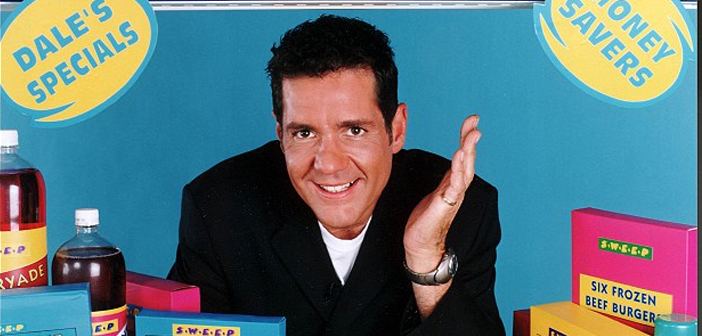
ABC's Supermarket Sweep was broadcast from Food Fair supermarkets, mostly around New York City. For the Lifetime version, a mock supermarket was created at Hollywood Center Studios. It was modeled after a Hughes Family Market (which was later merged into the Ralphs chain in 1998) until April 2000, when it was remodeled again after a Unified Western Market. The first season of the PAX version was filmed at Santa Clarita Stuidos in Santa Clarita, California. Beginning in August 2001, the show moved to NBC Studios.
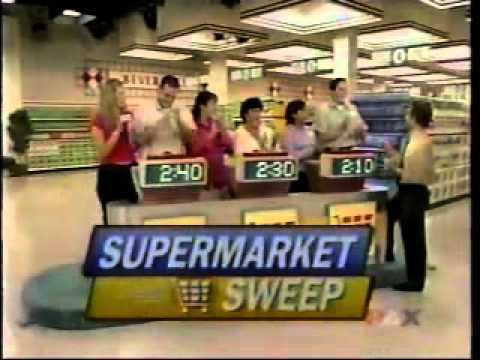
The host for the ABC version was Bill Malone. The announcers were Wally King from 1965 to 1966 and Richard Hayes from 1966 to 1967, with Johnny Olson and Gene Wood as frequent substitutes during those years. The host for the Lifetime and PAX versions was David Ruprecht. The announcer was Johnny Gilbert from 1990 to 1995 and again from April to June 2000, with Randy West taking over for Gilbert in 2000 and continuing for the rest of the series.

Supermarket sweep may 2002
ABC version
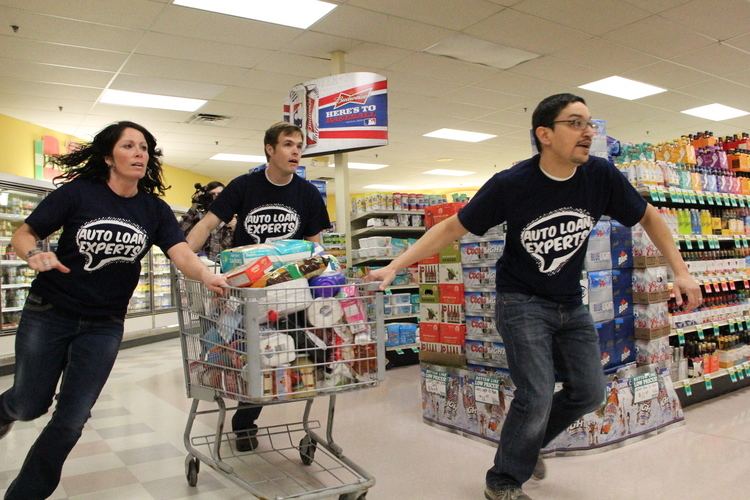
Three teams competed. Each team began with a base time of 1:30. In the first part of the game, one contestant from each team was shown a grocery item and were asked to guess its retail price. The team who came the closest won the item and an additional 15 seconds to their time. Four items were played.
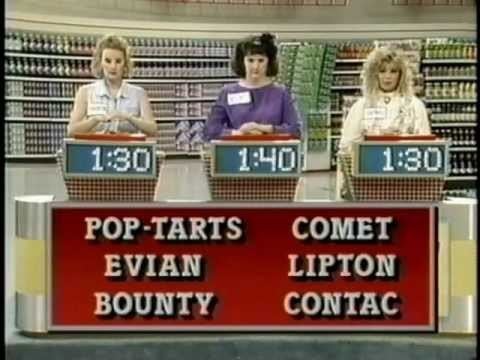
In the second part of the game, one contestant from each team went on a shopping spree through the market, using the time accumulated in the first half of the game. Bonus items worth $10–$100 were also spread throughout the store. All teams kept every item they picked up, with the team with the highest total in groceries, bonus prizes and other items winning the right to return to the show and play in the next game.
Lifetime/PAX versions
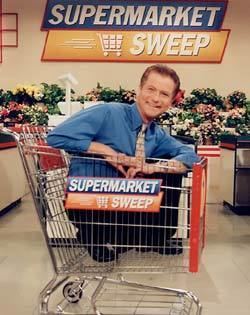
The gameplay of the Lifetime/PAX version of Supermarket Sweep consisted of three segments: the question round, the Big Sweep and the Bonus Sweep. The game was played between three teams of two related individuals, such as a parent and child, spouses, siblings or best friends. In the last two rounds, the team members wore sweatshirts of the same color: Team 1: Light Blue or Red; Team 2: Red or Light Blue; Team 3: Yellow. The show gave the appearance that pairs were chosen to be contestants based on who in the audience (or in the show's last two seasons, the market) held pre-distributed grocery items that the announcer called for at the beginning of the show.
Question round
Like the ABC version, all three teams started with a base time of 1:30. The questions answered correctly added time to their clocks. The round was divided into three segments; in the first two segments, one teammate from each team answered a variety of questions and/or played one of several games that involved pricing everyday grocery items, with the teammates switching between segments. The third segment was the Round Robin game, in which the teammates rotated after each question.
Question types
Contestants were asked a series of questions, usually with specific brands of grocery items as answers; each question was worth 10 seconds. In each round, the questions followed a specific format, which varied between rounds and shows. The formats used on the show included:
Pricing games
During each segment, different games were played involving everyday groceries. These games varied from day to day and generally involved the following objectives:
Other variants that did not involve pricing items included:
If a contestant was correct, the team earned 10 seconds. In the case of games where each contestant had to choose which answer they thought was right, 30 seconds was awarded to each team if all three chose the correct answer.
Special games
Round Robin game
For the final segment before the Big Sweep, the players that played the first half of the game were called back out and each took turns attempting to answer a series of six (originally four) puzzles about a product or a brand name featured in the supermarket. Each correct answer was worth ten seconds.
The Round Robin game was played several ways, with the most common being an "unscramble the word" game. The three teams would be shown the scrambled word or words in the brand name, and three clues would be read one at a time to try to lead the players to the correct answer. If after all three clues were read no answer was given, they were repeated in a rapid-fire fashion and the teams had one last chance to answer. If they still could not answer, the solution was given and nobody received any seconds.
Sometimes, the round was played with no scrambled word, with five clues read one at a time.
Mini-Sweep
Beginning in season 3, a Mini-Sweep was played at the beginning of the first round. A toss-up question (usually a rhyming couplet) was asked with a particular product as the answer. The team that correctly answered the question earned ten seconds, as well as a chance for one team member to run into the market to retrieve a package of that product marked with the show's logo. If the product was returned within 30 seconds, the team won $50 towards their Sweep total. Failing to find the marked package, returning it after time ran out, or bringing back an unmarked package or one of an incorrect product, awarded no bonus.
A year after its debut, the bonus was doubled to $100 if the product was brought back within 20 seconds. Starting with the fifth season, a second Mini-Sweep was added at the beginning of the second round, and while this was later discontinued as a regular feature, it would be used during special weeks on the PAX version.
Big Sweep
The "Big Sweep" was the chance for the teams to run throughout the supermarket and take products from the shelves with the seconds they had earned in the front game. One player for each team was designated as the "runner," with the job of collecting items in a shopping cart, and the teams were assigned numbers based on their accumulated time: 1 for the most, 2 for the second-most, 3 for the least.
The clock for the Big Sweep was set to the leading time, and it started when Team 1 was sent into the market. Teams 2 and 3 were sent in when the clock displayed their respective times. If any of the teams were tied, they were sent into the market at the same time.
At any time, runners could bring full carts back to their teams' cash registers and exchange them for empty ones. When time ran out, only items in the runners' carts were included in the team totals. While the runners were in the market, the show's announcer offered commentary on the proceedings.
The three main rules for the Big Sweep were:
The product limit, which was absent in the original ABC version of the show, was added to prevent a team from overloading their carts with expensive items, such as poultry, laundry detergent or over-the-counter drugs.
In most episodes early in the show's first season on Lifetime, costumed characters such as Frankenstein's monster, a gorilla or a creature named Mr. Yuck ran through the aisles during the Sweep. If the character came near a contestant or vice versa, the contestant had to turn around and go in the other direction. The characters were dropped later in the season.
Once the clock reached zero, a bell rang to signify the end of the Big Sweep and the runners had to stop whatever they were doing and return to the registers. All of the products were scanned while the show took a final commercial break, and the grand totals of each team's takes were revealed when the show returned beginning with Team 3. Each team's groceries were tallied and any bonuses/penalties were applied to determine the final totals. The team with the highest score won their Sweep total in cash and advanced to the Bonus Sweep for a chance to win an additional $5,000. The other teams received parting gifts. Sweep totals included cents in the first season, but were subsequently rounded to the nearest dollar.
Bonuses
Many bonuses were available during the Big Sweep at different times during the show's run. Each contestant was only able to take one of each bonus type. Except for the Bonus Specials shown below, all items picked up by the runner had to be in the shopping cart (and properly bagged/sealed, if necessary), or over the red line painted on the floor around the checkout counters, before time ran out in order to count. Some of these included:
Bonus Sweep
In the Bonus Sweep, the winning team was given 60 seconds to find three different items. Ruprecht read a clue to lead the team to the identity of the first item, and once he was done the team darted into the market to try to find it as the clock started. The correct item was tagged with the show's logo and a clue for a second item to be found. This item in turn had a clue for a third one, which had the $5,000 prop tucked in next to it. In order to win, the team had to find all three items and be holding both the third one and the money prop before time ran out. If they fell short, they received $200 for each item they had found.
Originally, if the team found the final product and the $5,000 before either of the other two, they automatically forfeited the bonus round. However, after the first two seasons, this was changed so that an overhead announcement was made reminding the team to find the first two products, then return to the third product and claim the cash.
Tournaments
During both runs of the show, special tournaments were held periodically, as well as other individual shows in which former teams were invited back for a chance to win more money or a trip.
Twin Car Giveaway
From September 5–30, 1994, at the beginning of the show's final season on Lifetime, a month-long Twin Car Giveaway tournament was held. During the first three weeks of the tournament, a standard game was played each day. The twelve teams with the highest Big Sweep totals from these episodes at the end of the third week returned for the fourth and final week, in which games were played with no Mini Sweep or Bonus Sweep. The six teams with the highest Big Sweep totals during that final week returned for the Friday show to play for a pair of Geo Trackers. On the Friday show, the first three teams played an eight-question Round Robin game, where each correct answer was worth $50 towards their Sweep total. Each of the first three teams then had a flat three minutes in the Big Sweep. This process was repeated for the other three teams. At the end of the show, the team with the highest Big Sweep total won the two cars (a combined value of more than $25,000) in addition to whatever else that they won on their previous shows. All other teams kept their prior winnings.
Other tournaments and specials
Occasionally, former teams were invited back to play for additional money or a trip. These consisted largely of "Sweeps of Champions" (later called "Second Chance"), which gave previous winners a chance to go on another Bonus Sweep for the opportunity to play and get a second chance at $5,000. On a few early "Sweep of Champions" episodes, former contestants were invited back for a chance to double their money to $10,000.
Several special week-long contests were held in which the bonus sweep was not played at the end of each episode. Instead, the team winning the week-long contest was guaranteed to win $5,000 at the end of the Friday episode. This included "You Can't Lose!" (which featured former teams who lost during their first appearance), "Tournament of Heroes" (featuring teams of military members) and "Family Week". Other contests, such as "Cruise to Paradise" and "Cruise Week", featured teams competing for a grand prize of a cruise, awarded to the team with the largest Big Sweep total at the end of the week.
"Double Your Money Week", a contest featured on the PAX version, invited the three highest-winning teams from the Monday through Thursday episodes to compete again on Friday, with the grand total of the team who won the final Big Sweep that day doubled to $10,000.
Another special feature, "Mother-Daughter Week", featured mother-daughter teams competing, sometimes with daughters under the age of 18.
Episode status
Seven episodes of the 1960s version survive and are owned by HBO, which controls most of the Talent Associates library (the rest were destroyed to recycle film). The Lifetime/PAX version remains intact and is owned by Al Howard. In early 2015, the pilot episode for the Lifetime version was posted on YouTube by Wink Martindale as part of his "Wink's Vault" series of rare game show findings.
FremantleMedia and its subsidiaries own most of the international versions. The Canadian version airs in reruns on GameTV, and the British version airs in reruns on Challenge.
Merchandise
A board game based on the original ABC version was manufactured by Milton Bradley in 1966.
A video slot machine based on the Lifetime/PAX version was released to North American casinos by WMS Gaming.
